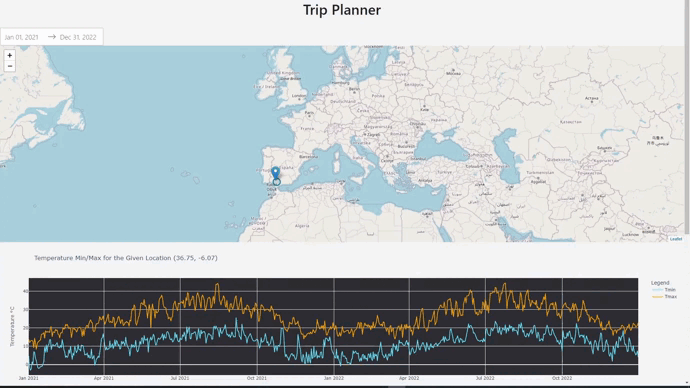Interesting APIs 101 | ElevenLabs vs AI Studio
Tl;DR
No matter if you are using APIs to BiP.
To do some Jira tasks or to bring real time life data to your SliDevJS PPT component.
99% of the times, there is an API behind of that!
Intro
Whenever you go to a restaurant, you see the menu and order what you want.
You dont care of how its prepared in the kitchen.
Same with API’s: you ask for something, you get it.
And we can do all kind of things with them.
Like using it to push new content/posts programatically to WP or Ghost.
Scrapping APIs
There are several scrapping APIs outthere.
The most used are: Firecrawl > ScrapeGraph / Crawl4AI
 Scrapping the Web
Scrapping the Web- Octoparse is a popular no-code web scraping tool designed to automate data extraction from websites.
About OctoParse… 📌
- Visual Workflow Designer: Allows users to create scraping tasks by clicking elements on web pages. No programming knowledge is needed, making it beginner-friendly for simple scraping jobs.
- Template Library: Comes with pre-built templates for hundreds of popular websites—such as Amazon, LinkedIn, and Twitter—so users can quickly start extracting data with minimal setup.
- Smart Extraction & XPath: Offers smart extraction modes for auto-detecting lists or tables. Advanced users can utilize XPath and regular expression support for precise targeting.
- Cloud & Desktop Versions: Runs locally on Windows computers or on Octoparse’s cloud servers. The cloud service supports scalable scraping, task scheduling, and concurrent extractions for large jobs.
- Handles Dynamic Content: Capable of processing AJAX, JavaScript, multi-page navigation, infinite scroll, and data behind logins. It also supports IP rotation and proxies to bypass blocking mechanisms.
- Data Export Options: Data can be exported in various formats—CSV, Excel, JSON, HTML, XML—or directly to databases. There’s also API access for programmatic integration.
- Error Handling & Performance: Performance is usually fine for simple tasks but degrades with complex workflows, dynamic content, or large-scale scraping. Users report some reliability issues and a learning curve for advanced features.[1][2][3][4]
- Support & Documentation: Offers 24/7 support for paid users, though some users complain about slow response times and sparse documentation for more complex use cases.
- Use Cases: Commonly used for market research, price comparisons, lead generation, competitor analysis, and business intelligence tasks.
- Cons: Struggles with sites heavily reliant on JavaScript frameworks (React, Angular, Vue), advanced anti-scraping techniques, and complex authentication flows. There might be occasional issues with templates breaking if webstes update their structure and with heavy-duty workflows being slow or prone to minor glitches.
Octoparse is ideal for non-programmers and small businesses needing rapid data extraction from the web without building custom scrapers, but mission-critical scraping or heavy automation is sometimes better handled with custom-coded solutions or other advanced tools.
- ZenRows is an advanced web scraping SaaS platform focused on making large-scale data extraction from difficult, protected websites easier for developers and businesses.
About ZenRows… 📌
- Universal Scraper API: Lets you extract raw HTML or structured data (like JSON) from any URL, handling proxy rotation, headless browsers, CAPTCHAs, and anti-bot protections automatically.
- Autoparse: For supported sites, it can deliver pre-parsed, structured data—saving time if you don’t want to write your own data extraction logic.
- Prebuilt Scraper APIs: Provides specialized endpoints for major e-commerce and social sites, so you can pull structured data directly.
- Cloud-Based Scraping Browser: Supports headless scraping for JavaScript-heavy or highly interactive sites, compatible with Puppeteer and Playwright scripts.
- Residential Proxies & Anti-Bot: Offers 55 million+ residential IPs worldwide and automatic techniques to bypass blocking and bot detection.
- Developer-Focused: Well-documented API and SDKs for Python, Node.js, Selenium, and more, making it appealing for those comfortable with code.
- Concurrency & Scale: Supports high numbers of parallel requests and session management for persistent scraping.
Pros:
- Excels at bypassing advanced anti-scraping protections, even on sites with CAPTCHAs or strong bot defenses.
- Handles proxies, sessions, and parsing, so you can concentrate on what data you need.
- Support is praised as responsive and helpful.
- Suitable for dynamic and complex targets.
Cons:
- Steeper learning curve—despite some low-code claims, it’s not truly no-code; technical knowledge is recommended.
- Interface and workflow are less intuitive for beginners compared to tools like Octoparse.
- Pricing is higher than many competitors, with forced parameters (like requiring premium proxies or JavaScript rendering) on some sites raising API costs.
- Minor quirks with auto-parsing feature maintenance—if a target site changes structure, auto-parsing may break until ZenRows updates the template.[1][2][3][4][5][6]
Bottom line: ZenRows is best for developers and teams needing to reliably scrape challenging or protected websites at scale—especially where anti-bot solutions and CAPTCHAs are an obstacle.
It is much more powerful than no-code tools for technical users needing robust API-based scraping, but less friendly for those without development skills.
ZenRows is a web scraping SaaS platform designed for developers and businesses that need to extract data from websites at scale, especially those protected by anti-bot systems and CAPTCHAs.
Here’s what makes ZenRows noteworthy:
- Universal Scraper API: You can send any URL and get back raw HTML or structured JSON. Proxy rotation, headless browsers, and anti-bot bypass are handled behind the scenes.
- Autoparse: For supported sites, ZenRows delivers structured JSON automatically, so you don’t have to build your own parser.
- Developer-Focused: SDKs and examples exist for Python, Node.js, Selenium, Puppeteer, and more, with a strong focus on API workflows and automation.
- Handles Dynamic Content: Cloud-based headless browser lets you run Puppeteer/Playwright scripts for JavaScript-heavy or interactive sites.
- Residential Proxies and CAPTCHA-Solving: Over 55 million rotating IPs and automated anti-bot systems.
- Strong Support: Responsive, developer-savvy support team.
- High Performance: Reliable at scraping most protected websites, with solid speed.[2][5][7][1]
Cons:
- Not truly no-code—basic web/HTTP/API skills are necessary. Its UI can feel less intuitive for beginners compared to tools like Octoparse.
- Higher price point ($69/month and above) than many competitors, and premium features (JS rendering, proxies) sometimes force higher API cost per request.
- If a target website’s structure changes, the autoparse feature might lag until the template is updated.
ZenRows is best for technically adept users needing to scrape protected or dynamic sites robustly and at scale, while not really aimed at true beginners or one-click/no-code users.
- Exa (https://exa.ai) is a developer-focused Web Search API, AI Search Engine, and Website Crawler designed to power applications needing real-time, accurate, and comprehensive web data. Here’s what makes Exa distinct:
Search built for AI
About Exa… 📌
- Web Search API: Exa provides multiple API endpoints to search the web, retrieve contents, extract structured data, and crawl websites. Developers can integrate web search and retrieval directly into their applications or AI models.
- Retrieval-Augmented Generation (RAG): Exa is optimized for RAG use cases—where language models combine retrieved factual web data with generated responses for higher accuracy and up-to-date answers.
- High Customizability: You can tailor searches by domain, location, semantic category, and more, giving precise control over data relevance.
- Specialized Models: Exa’s infrastructure powers specialized indices—for instance, searching Stack Overflow, coding docs, GitHub, LinkedIn, news, and niche reference material. It also provides market prediction models using historical web data.
- Recent & Historical Coverage: Exa indexes content from thousands of docs, PDFs, and web pages, covering both current trends and historical data for research, market analysis, and more.
- Privacy & Compliance: Exa offers strong privacy controls, purging queries/data as required, maintaining high compliance standards, and supporting enterprise requirements with DPAs and SLAs.
- Developer Integrations: Companies like Notion, Flatfile, and Cursor use Exa for research modes, candidate sourcing, and code referencing. Exa supports high-volume, secure integrations for teams and user authentication.
- AI Grounding: Exa can “ground” LLMs in real-world, factual data—enabling more credible, up-to-date, and trustworthy AI outputs.
Summary:
Exa is a powerful API and search engine for developers and AI platforms needing live, reliable access to web data—whether for agentic automation, research workflows, candidate sourcing, market intelligence, marketing analysis, or RAG pipelines.
It’s frequently described as “Perplexity-as-a-service” for customizable, factual, and privacy-conscious web data access.
AI APIs
Avoid LLM lock-in and the recurring subscription bills.
Simply use APIs.
- OpenAI API Keys - https://platform.openai.com/api-keys
- Anthropic - https://console.anthropic.com/settings/keys
- Groq - https://console.groq.com/keys
- For Ollama, you need this setup
Together with Streamlit!
OpenAI: They have released recently o3-mini model.
GPT-4o-mini has been my go to in terms of value per money.
But we have now o1 (mini also) and o3-mini with higher context window (200K)
pip install openai==1.61.0See the latest openAI models:
import os
from dotenv import load_dotenv
from openai import OpenAI # pip install openai>0.28
# Load environment variables from the .env file
load_dotenv()
client = OpenAI()
models = client.models.list()
for model in models:
print(model.id)But you can also use the Grok API
Or the latest DeepSeek via Ollama:
Companions for this multichat.
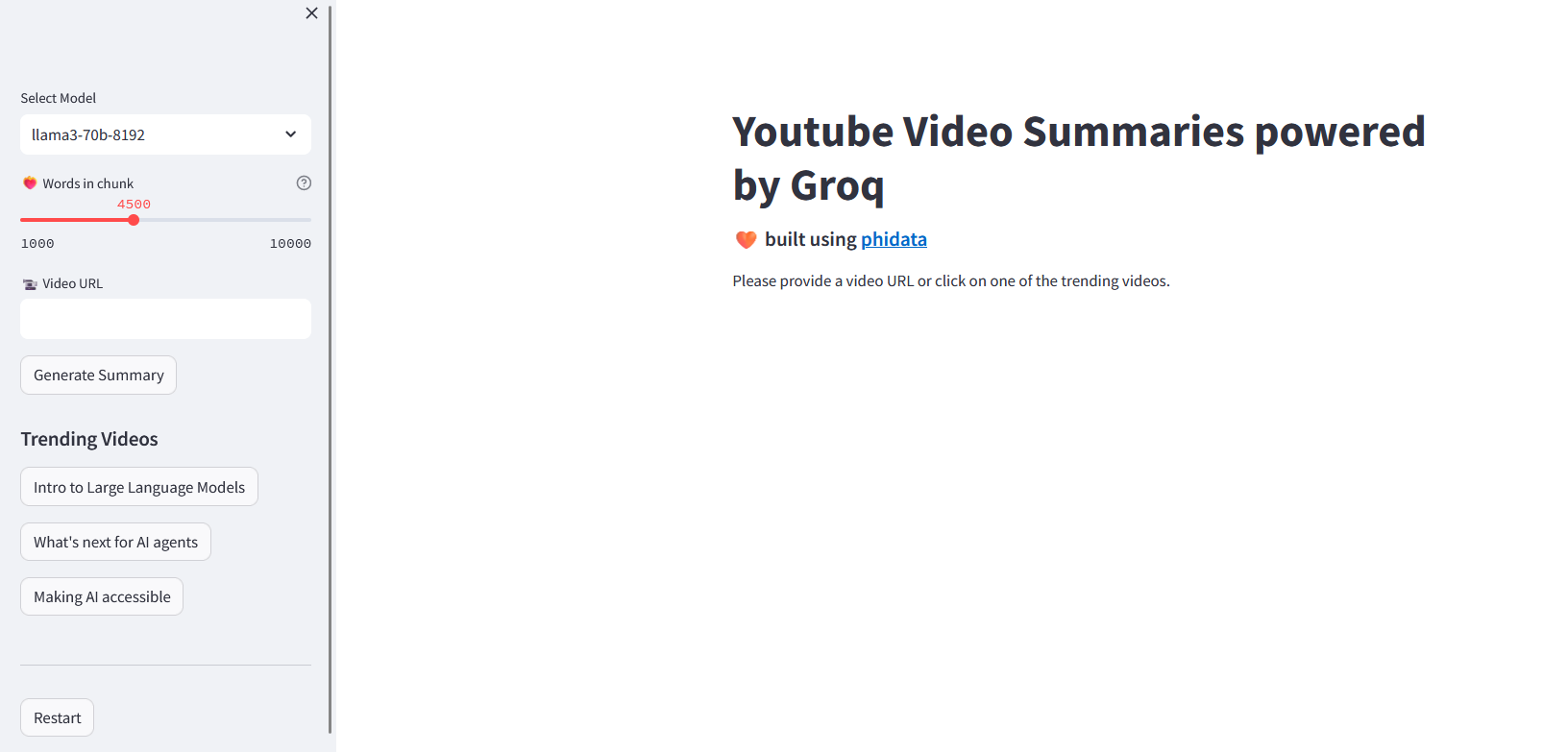
Agents with Streamlit
With a very interesting article about agents: https://www.anthropic.com/engineering/built-multi-agent-research-system
FULL v0, Cursor, Manus, Same.dev, Lovable, Devin, Replit Agent, Windsurf Agent, VSCode Agent, Dia Browser & Trae AI (And other Open Sourced) System Prompts, Tools & AI Models.
AIssistant?
Or simply a YT Summarizer:
OpenAI API
We can do many cool things with just simple LLM API calls:
Data APIs
You can get data from other users/services that have collected/processed and expose it for you.
In case you want to create & expose your own API endpoints with code, for example with FastAPI or with Pocketbase BaaS.
Im aware that there are many APIs around: https://github.com/public-apis/public-apis
Even for crypto, with Dune Analytics, official docs
Weather
This was one of the first data I used for a personal project.
Im talking about the python trip planner, which uses the open meteo API to get historical weather data points.
See the open meteo endpoints: https://api.open-meteo.com/v1/forecast?city=${city}&daily=temperature_2m_max&timezone=auto
There is also a PirateWeather API: https://github.com/Pirate-Weather/pirateweather or https://opendata.aemet.es/centrodedescargas/inicio
Which is a weather api alternative, but both require an API key
We also have:
curl http://wttr.in/madridFinancial Data
This time is going to be yfinance based.
That I also covered recently on this post: https://jalcocert.github.io/JAlcocerT/python-financial-data-with-yfinance/
Formula 1
If you watch F1, you might be aware that AWS can bring you data: https://aws.amazon.com/sports/f1/
Which Im not sure its a part of AWS free tier https://aws.amazon.com/free/?nc2=h_pr_ft
But, I got to know recently about: https://www.f1-tempo.com/ and https://www.gp-tempo.com/
Puedes acceder a telemetría de F1 en tiempo real y datos históricos usando APIs y webs especializadas como OpenF1, FastF1 y soluciones comerciales como Formula Live Pulse.
Todas son populares entre fans, analistas y desarrolladores.
Fuente | Gratis | Open Source | De Pago | Notas
———————+———-+—————+———–+————————————————————————————
OpenF1 | Sí | Sí | No | API open source para datos en tiempo real e históricos, usada por desarrolladores.
FastF1 (Python pkg) | Sí | Sí | No | Biblioteca Python para acceder a telemetría oficial, análisis y visualización.
Formula Live Pulse | No | No | Sí | Plataforma comercial con API en tiempo real y widgets personalizables.
f1-dash.com | Sí | No | No | Dashboard web gratuito para telemetría en vivo y comparación de sectores.
TracingInsights.com | No | No | Sí | Servicio pago enfocado en análisis y gráficos de telemetría detallados.
F1 TV (App) | No | No | Sí | Servicio oficial de F1 con telemetría, contenido premium y transmisiones.
Ergast API | Sí | Sí | No | API gratuita y open source para estadísticas históricas, no telemetría en vivo.
- OpenF1 API: Ofrece datos en tiempo real y acceso gratuito a históricos, incluyendo telemetría, comunicaciones y vueltas. Ideal para dashboards o análisis detallado. Documentación y ejemplos en openf1.org.
- FastF1 (Python package): Permite extraer telemetría, tiempos por vuelta, posiciones, acelerador, freno y más directamente desde los feeds oficiales. Fácil de usar con Pandas y Matplotlib para visualizaciones. Instalación vía pip o conda.
- There is also an R version: https://cran.r-project.org/web/packages/f1dataR/index.html
- Formula Live Pulse API: Real-time telemetría, tiempos, análisis de neumáticos y comparaciones entre pilotos. Ofrece widgets personalizables y está disponible para web, iOS y Android.
Opciones en Web y Apps
- f1-dash.com: Dashboard en tiempo real con telemetría y tiempos de carrera online, sector por sector y comparaciones directas.
- TracingInsights.com: Analítica y gráficos interactivos de telemetría y rendimiento, comparando pilotos y vueltas.
- F1 TV App: Oficial de F1, incluye mapas, telemetría, tiempos y está disponible en App Store y Google Play.
- DigoRaceDash Lite: App gratuita compatible con F1 24 para mostrar telemetría detallada en tu móvil, sin hardware extra.
Comunidad y Recursos Técnicos
- En Reddit y blogs técnicos, recomiendan FastF1 y OpenF1 como principales fuentes para programadores y analistas. También se menciona Ergast para estadísticas históricas.[6][18]
Estas herramientas te permiten crear dashboards, realizar análisis y estudiar estrategias de piloto en tiempo real con gran profundidad.
A real-time F1 dashboard
- https://github.com/br-g/openf1 with official page
As simple as:
curl "https://api.openf1.org/v1/laps?session_key=9161&driver_number=63&lap_number=8"Social Media APIs
Some years back, I was pulling tweets and later applying the detoxify models on it.
Now the API has changed a bit: https://developer.x.com/en/portal/petition/essential/basic-info
X introduced a tiered pricing model in 2023 when it restructured API access.
- Free tier: Very limited access — typically for small personal projects or testing. Includes minimal monthly post and read limits, and usually no access to enterprise features such as filtered streams or high-volume endpoints.
Get familiar with: https://developer.x.com/en/developer-terms/agreement
| Tier | Cost | Intended Use | Main Limits |
|---|---|---|---|
| Free | $0 | Testing, small personal bots | Very low post/read limits |
| Basic | $100/month | Small projects | 3,000 tweets/month, limited endpoints |
| Pro | $5,000/month | Startups, higher access | Full read/write, filtered streams |
| Enterprise | Custom | Large businesses | Full archive, analytics, high-speed streams |
If you only need basic functionality (like pulling a few tweets or posting updates), the Free or Basic tier might be enough.
This doesnt mean that you cant use APIfy to pull stuff :)
I intend to use the X API to publish data-driven content focused on the historical performance of companies.
I want to write better content in less time, helped by Python analytics, so that quality and insightful content can reach further via posts and threads.
Additionally, I will use the API to monitor and understand which types of posts generate the most engagement and resonate best with other users who perform similar analyses.
The goal of this use is to continually improve the quality and relevance of the published content over time, based on observed user interactions and feedback patterns.
I plan to manually replying to comments and discussions on these posts to foster meaningful conversation and community building around such initial data driven postsBut for anything more advanced — analytics, large-scale data collection, or automation — you must pay.
After you submit, you get: https://developer.x.com/en/portal/dashboard
You are allowed to: Web App, Automated App or Bot, Confidential client
- Pull 100 posts a month
- Write 500 tweets a month
You will need to create the app:
Sth like: https://grow.libreportfolio.fyi/callback and https://grow.libreportfolio.fyi
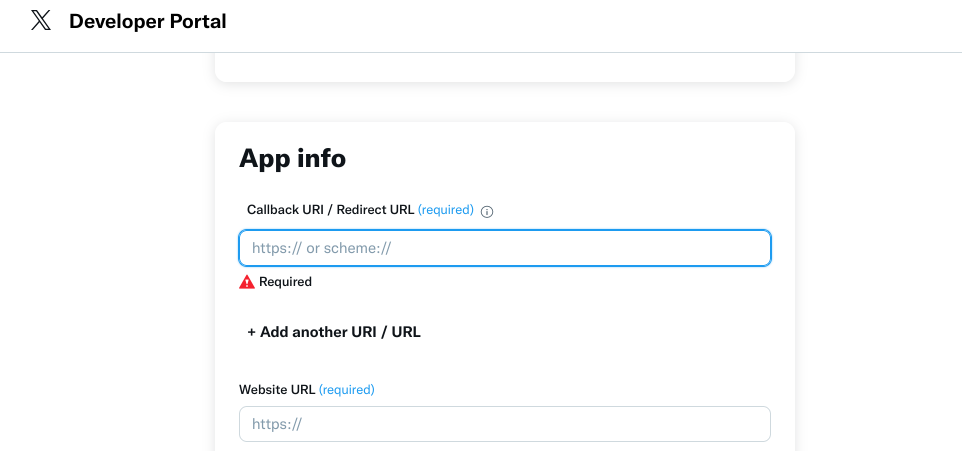
So that you get a clientID and clientSecret.
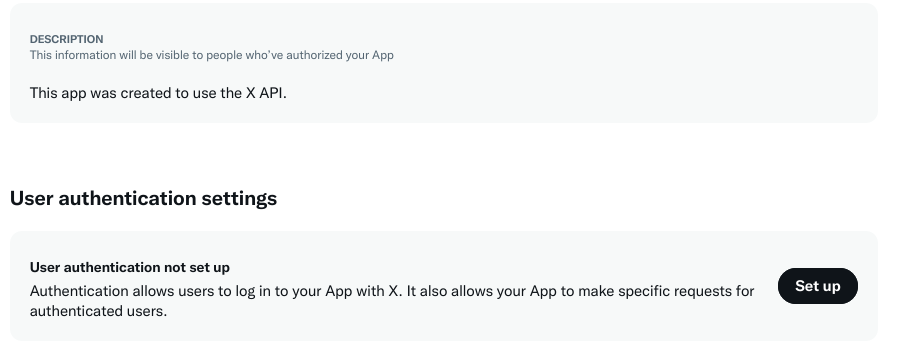
Here is your OAuth 2.0 Client ID and Client Secret https://github.com/xdevplatform/Twitter-API-v2-sample-code
Which is not a bearer token https://docs.x.com/fundamentals/authentication/oauth-2-0/bearer-tokens
Time to create some create_post_simple.py and bundle it around a quick Flask app.
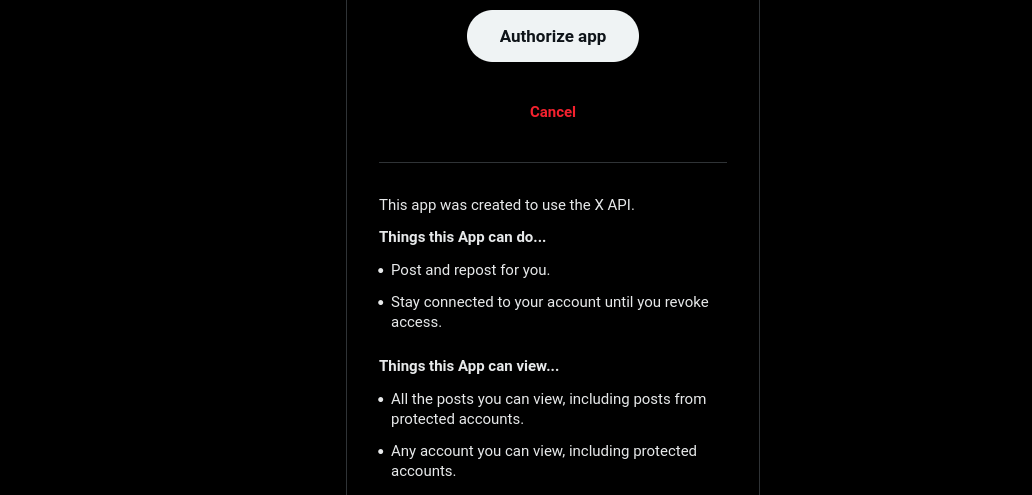
#git clone https://github.com/JAlcocerT/DataInMotion
cd OpenAI-Twitter-API
docker compose up -d
#sudo docker compose downGo to http://192.168.1.2:5033/ pointing to x-api-tweet-creator:5000
#docker network ls | grep cloudflared_tunnel
docker network connect cloudflared_tunnel x-api-tweet-creator #connect
#docker inspect x-api-tweet-creator --format '{{json .NetworkSettings.Networks}}' | jqnetworks:
#adventurelog_net: # Define the internal network
# nginx_nginx_default:
# external: true #for https
cloudflared_tunnel:
external: true # Mark the 'tunnel' network as externalAnd you will get a twitter post:
{"access_token_redacted":"abcdef...","has_refresh_token":true,"message":"User authenticated","token_type":"bearer"}So i could not resist to put together everything:
git clone https://github.com/JAlcocerT/LibrePortfolio-X.git
cd LibrePortfolio-X
#uv run app.py
sudo docker compose up -d
#sudo docker compose build --no-cache
#sudo docker compose downAnd add x-gen-ui:5088 to grow.libreportfolio.fyi
Then, each generation goes to https://grow.libreportfolio.fyi/preview/06cbbc68a88b and 4 graphs are uploaded with the comment.
Threads
The Threads API by Meta has specific limits designed to control usage and maintain platform integrity.
- Posting Limit: Up to 250 posts per 24-hour period per Threads account via the API.
- Replies Limit: Up to 1,000 replies per 24-hour period per account.
- Rate Limits: The number of API calls (requests) allowed per app or token is controlled by Meta’s Graph API rate limiting, which varies based on your app status and usage history.
- Business Verification: For production-level or larger scale usage, an approved and verified Meta business account is required.
- Data Access Limits: Access to user and content data through the API is governed by privacy and consent requirements, with limitations on the amount and type of data you can pull per request and over time.
| Limit Type | Limit | Description |
|---|---|---|
| Posts per 24h | 250 | Max number of posts created via API |
| Replies per 24h | 1,000 | Max replies made via API |
| API Call Rate | Varies | Subject to Graph API general limits |
| Account Required | Verified Business required | For large-scale or production use |
These limits ensure fair use and prevent abuse or spamming via automated tools on Threads. For more details, see the official Meta documentation: developers.facebook.com/docs/threads and the Graph API rate limiting page.
If you need more specific technical limits or help navigating them, I can assist further.
Random APIs
If the formula 1 data was not enough:
- Transform PDFs into markdown locally and quickly is possible thanks to kreuzberg as seen with the Jira post.
MIT | A collaborative list of public APIs for developers - https://publicapis.dev/
If you have a digital company in EE, also: https://apidocs.inforegister.ee/en
No-as-a-Service (NaaS) is a simple API that returns a random rejection reason. Use it when you need a realistic excuse, a fun “no,” or want to simulate being turned down in style.
Checking APIs
As we saw during the FastAPI post, here, there are few tools to check/test/interact with APIs.
Among all of them, is worth to get to know how to use Hoppscoth.
As an alternative to PostMan.
How to use Hoppscotch
When playing/creating APis…
wget https://github.com/hoppscotch/releases/releases/latest/download/Hoppscotch_linux_x64.deb
sudo apt install ./Hoppscotch_linux_x64.deb #https://hoppscotch.com/downloadOther API Testing Tools
These applications are all API Clients or API Testing/Debugging tools.
All three apps (HTTPie Desktop, Reqable, and yaak) perform the core function of an API client, allowing users to send requests, view responses, and organize their API development workflow, directly competing with or replacing tools like Postman.
wget -P ~/Applications https://github.com/httpie/desktop/releases/download/v2025.2.0/HTTPie-2025.2.0.AppImage
#httpie
With httpie we can also query endpoints that are protected. No matter if its basic user/pwd, APi Token or bearer!
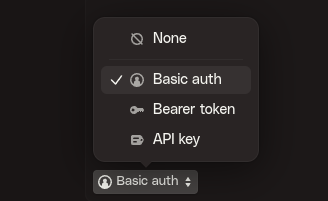
🚀 HTTPie Desktop — cross-platform API testing client for humans. Painlessly test REST, GraphQL, and HTTP APIs.
- Reqable - Reqable implements the core features of traffic analysis and API testing, and deeply integrates them.
One app is worth multiple apps: Advanced API Debugging Proxy and REST Client
Reqable = Fiddler + Charles + Postman
flatpak install flathub com.reqable.Reqable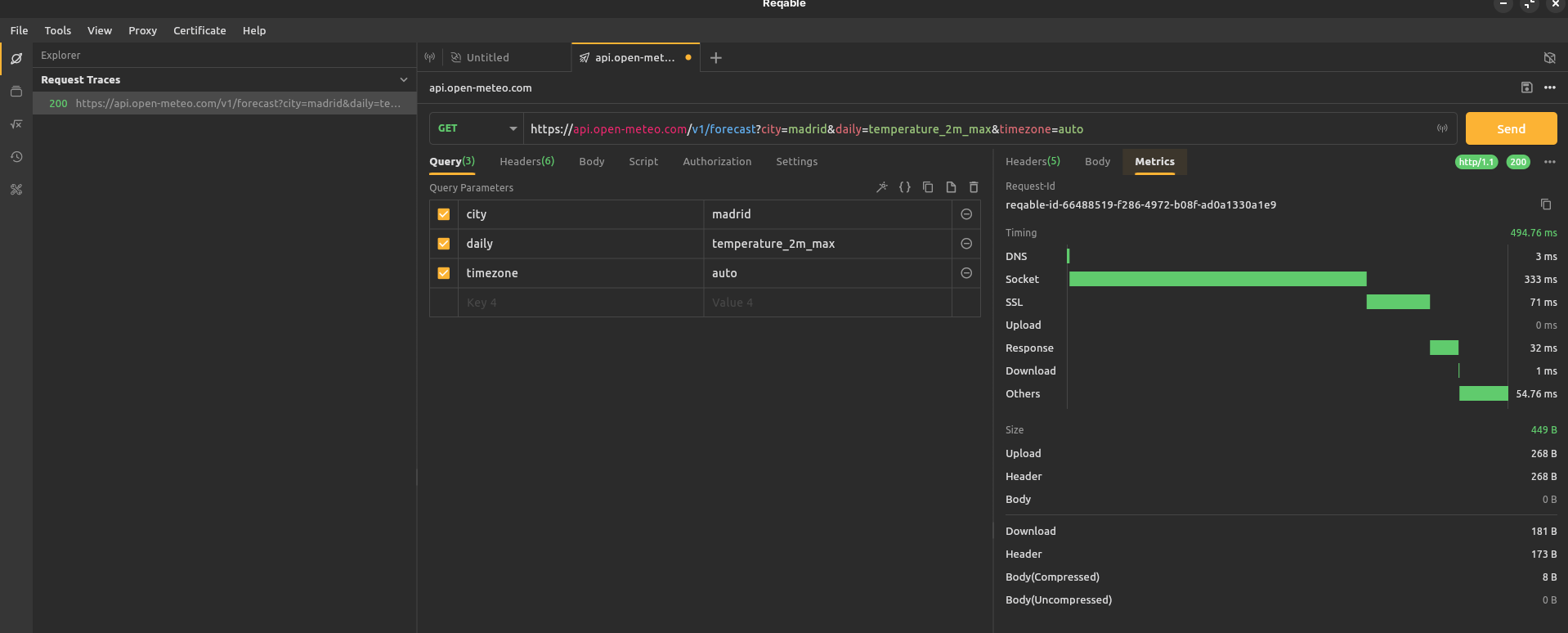
MIT | The most intuitive desktop API client.
Organize and execute REST, GraphQL, WebSockets, Server Sent Events (SSE), and gRPC 🦬
Conclusions
The problem today is not to have options, but too many:
- Smithery: An open platform and registry for managing, sharing, and deploying modular agentic tools (MCP servers) that extend AI assistants with real-world actions and data.
- Octoparse: A no-code/low-code web scraping platform for visually extracting structured data from websites, ideal for non-programmers and small businesses.
- ZenRows: A powerful API-based web scraper built for developers to extract data from dynamic, protected, or anti-bot websites at scale.
- Pipedream: A developer-oriented cloud automation platform for building, integrating, and running event-driven workflows that connect APIs, apps, and custom code.
- Exa: An advanced web search API and site crawler that powers AI and developer workflows with live, customizable, and accurate web data retrieval.
FAQ
I know that some marketers are using…
PipeDream
Pipedream is a cloud-based automation and integration platform designed for developers and technical users.
- https://pipedream.com/pricing - There is a free tier
It allows you to create workflows that connect APIs, databases, cloud apps, and event sources with minimal infrastructure setup.
Key points about Pipedream:
- Low-Code/Code-Optional: You can build workflows using a mix of pre-built steps (“actions”) and your own custom code in Node.js, Python, Go, or Bash. It’s not “no-code”—some programming/developer know-how is helpful for advanced automations.[1][2]
- Event-Driven Workflows: Automate processes triggered by events (webhooks, schedule, app activity, HTTP requests, etc.). A flow could start with a new form submission and end with an email sent, data added to Google Sheets, or anything else API-powered.[2][3][4]
- Massive App Integration: Natively connects with thousands of popular SaaS apps and their APIs—think Slack, Notion, AWS, Google, GitHub, Trello, databases, and custom endpoints. Useful for automating business, marketing, DevOps, or productivity tasks.
- Developer-Focused Features: Built-in code editor, version control, real-time debugging, execution history, error handling, and easy management of connections and secrets.
- Use Cases: ETL (Extract, Transform, Load) between systems, automation of business processes, scheduled reporting, CRM updates, social media posting, API orchestration, internal tool building, and more.[5][2]
- Pricing: Has a generous free tier, but limits on workflow invocations and event history; paid plans for heavier usage.[3]
- Comparison: Unlike Zapier or Make.com, Pipedream exposes the underlying logic/code—you get the power of serverless backend but managed hosting and easy debugging. It appeals to users who want flexibility, speed, and API agility.[6][1]
Summary:
Pipedream is ideal for developers wanting rapid, flexible automation between cloud services, APIs, and custom code, without managing servers.
It’s fast for prototyping, robust for event-driven scripting, and widely used for DevOps, SaaS, and workflow automation.
Not a true no-code solution; best suited for technically comfortable users.
Smithery
Smithery (or Smithery.ai) is a developer-focused platform for building, discovering, and managing MCP (Model Context Protocol) servers—modular tools that extend the capabilities of AI assistants, agentic systems, and language models.
Extend your AI with 7572 skills built by the community
MCP Registry: Smithery acts as a central hub (sometimes called “Google for MCPs”) where developers can discover and share MCP-compliant AI tools—these are small servers or extensions that connect AI models to real-world data, services (like GitHub, Gmail), files, APIs, and much more.[1][2][3][4]
Agentic AI Tooling: MCP servers let AI agents perform specialized tasks, such as web search, code execution, file management, memory recall, automation with external services, cloud browsing, and so on. Smithery routes each AI agent to the right MCP server for its needs via a dynamic toolbox.
Local & Hosted Installation: Servers can be run locally (with CLI and Docker support) or hosted in the cloud. Smithery enables easy installation and management—often a single command will set up an MCP server, inject credentials, and register the endpoint for use by AI agents in your environment.[2][5][6]
Developer Integration: Designed for modern dev ecosystems, Smithery integrates with GitHub (for CI/CD and code sharing), VS Code, Docker, Node.js, and major LLM platforms (Claude, Cursor, etc.). There’s robust support for versioning, automated deployment, and environment variable configuration.
Privacy & Security: Credentials/tokens (like your GitHub PAT) are generally managed locally and not stored on Smithery’s servers. Audit logs, team permissions, and best practices help secure collaborative workflows.[7][2]
Accessibility & Scale: The platform is open source (Apache 2.0 license), with frequent updates and a fast-growing community registry—recent counts claim thousands of MCP tools and daily usage in the tens of thousands.[4][1][7]
Use Cases: Example MCP servers include web search plugins (like DuckDuckGo), automation helpers for software planning, code management, external database connectors, browser automators, and more. Developers can build new MCP servers for virtually any system their agents need to access.[5][6][8]
Summary:
Smithery is the “app store” or registry for agentic AI extensions, enabling powerful automation and integration between LLM-powered agents and real-world apps/services.
It’s especially useful for developers creating advanced personal finance, coding, or infrastructure management systems with agentic or autonomous logic.
Audio APIs
Powerful Translator: https://www.deepl.com/en/translator
If you like Podcasts
We were recently tinkering with AI and audio here
 OpenAI TTS and Transcription Project
OpenAI TTS and Transcription Project11Labs
11labs has really cool API endpoints.
And ElevenLabs already has its own MCP Server:
But I felt like trying elevenlabs and test how they can do audio was already overdued.
So…
Lets get to it: https://elevenlabs.io/pricing
As of the time of writig:It offers 10k credits/month for free.
- 10 minutes of Text to Speech
- 5 minutes of Music
- 250 seconds of Sound Effects
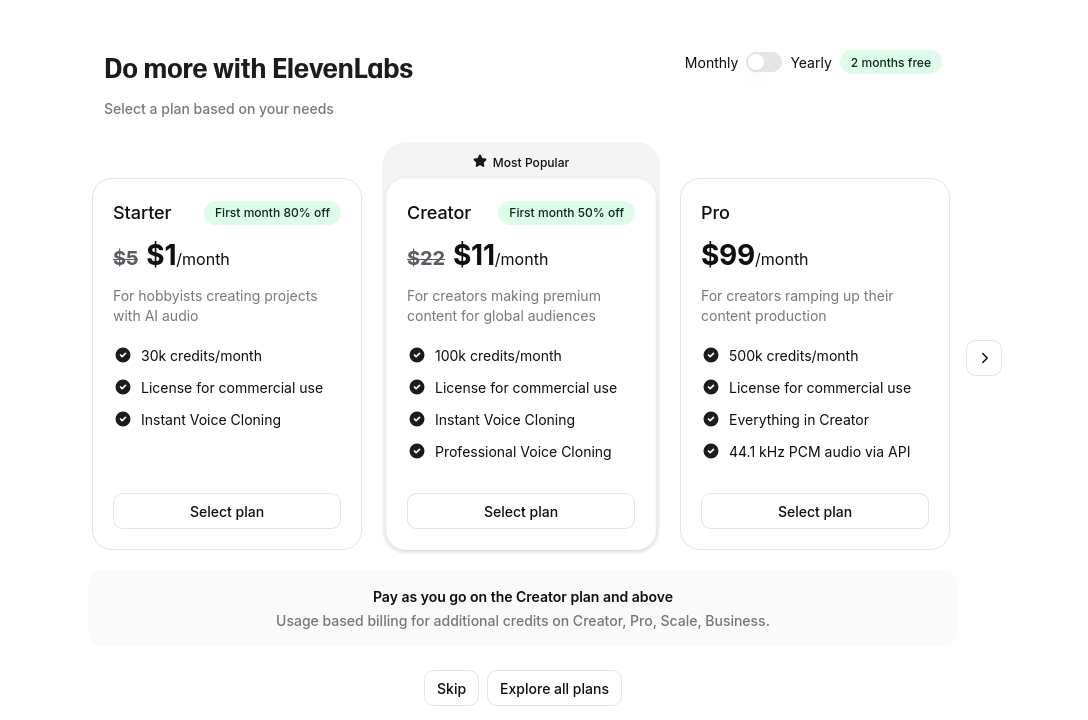
Eleven labs has one of the coolest onboarding experiences I have seen lately: https://elevenlabs.io/app/onboarding
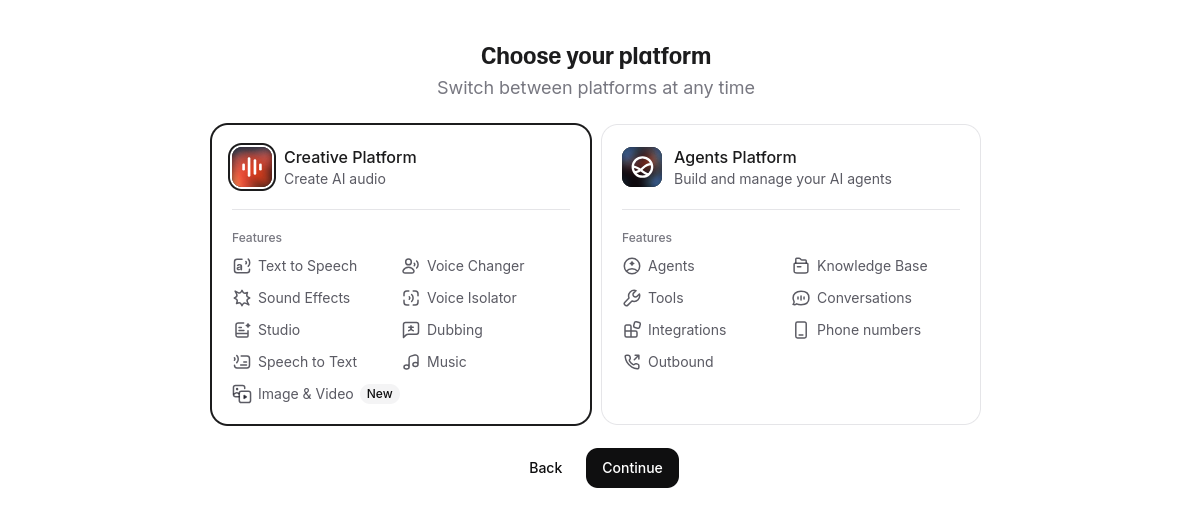
Once completed, you can explore on the free tier, like: https://elevenlabs.io/app/speech-synthesis/text-to-speech
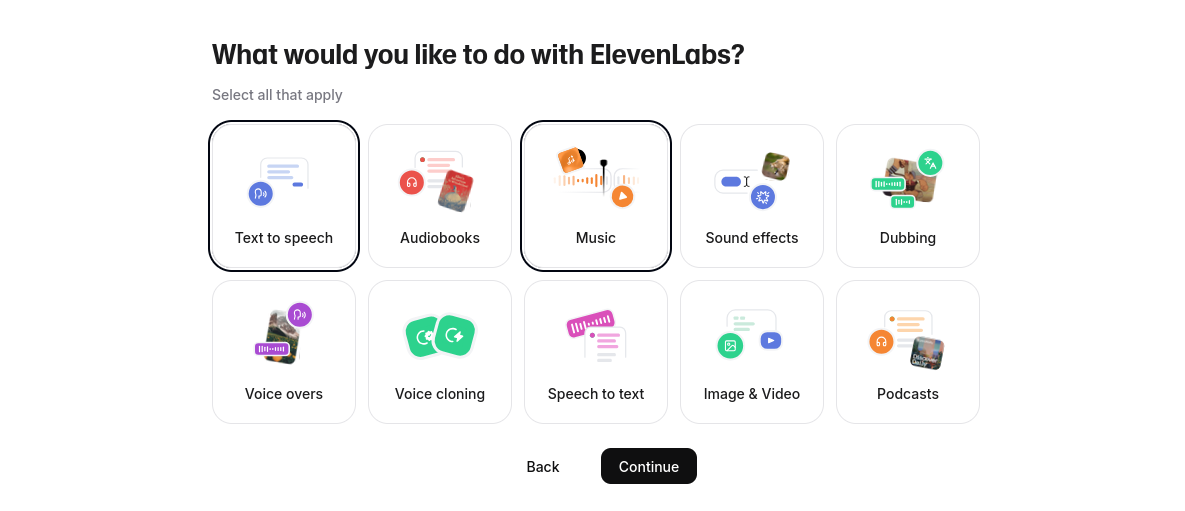
See how crazy it sounds:
Many people believe that successful negotiating hinges on reasoning and raw intellectual process.
Foundational texts of negotiation, such as Getting to Yes and Thinking, Fast and Slow, reinforce this impression. 
These 213 chars, took each one credit, with a total of 13s -> 9,787 credits remaining for the month.
Following the proportions, the total should be enough for ~600s=10 min of TTS generated audio.
But here is the audio output: ./audio/sample-t2s-11labs.mp3
Say thanks to this vibecoded HUGO shortcode for audio btw
Sources from
./static/audio/and you will change it to github raw to work outsidehugo serverlocally
I could not avoid comparing the elevenlabs TTS to the one that Gemini offers
Gemini TTS via Google AI Studio
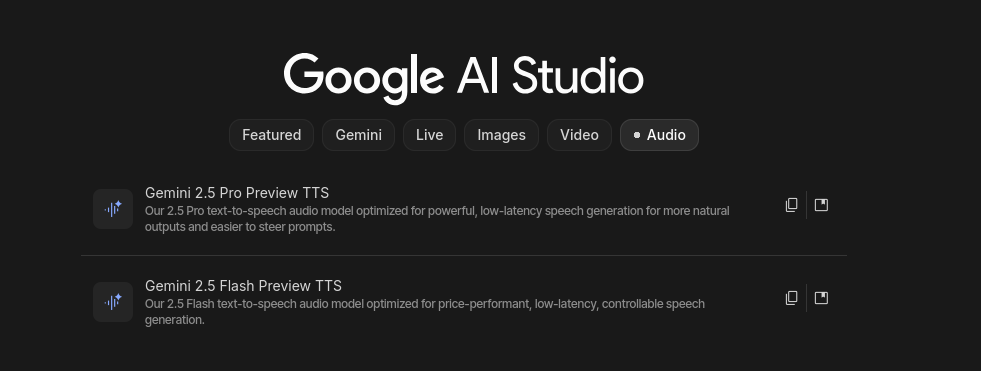
They also provide the code to run the same via Python and your own API key.
All powered by: https://pypi.org/project/google-genai/
pip install google-genai
Other Tools
gpl 3.0 | Open Source AI Calling Transcriptions, Summaries, and Analytics built on OpenAI Whisper
agpl | No Code Web Data Extraction Platform • Turn Websites To APIs & Spreadsheets In Minutes
MIT | An automated document analyzer for Paperless-ngx using OpenAI API, Ollama, Deepseek-r1, Azure and all OpenAI API compatible Services to automatically analyze and tag your documents.
MIT | LangGraph solution template for MCP
Creating TwitterOpenAIMatplotlib Bot
How about creating some AI/Bot that publish content on twitter?
git init
git branch -m main
git config user.name
git config --global user.name "JAlcocerT"
git config --global user.name
git add .
git commit -m "Initial commit: Starting LibrePortfolio x Twitter OpenAI Matplotlib Bot"
#sudo apt install gh
gh auth login
gh repo create LibrePortfolio-X --private --source=. --remote=origin --push

